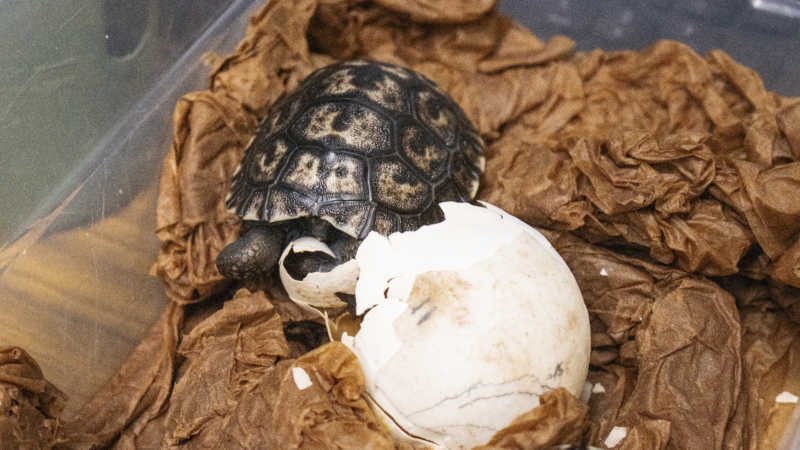Four critically endangered Galápagos tortoises hatch at the Philadelphia Zoo
A pair of Western Santa Cruz Galápagos tortoises, who are estimated to be around a century old, have become parents for the first time at the Philadelphia Zoo.
The arrival of four hatchlings to “Mommy” and “Abrazzo” is a “first” in the zoo’s 150-year-old history, contributing to the population of a critically endangered species.
Mommy, who has lived at the zoo for nearly 93 years, is seen as one of the most “genetically valuable Galapagos tortoises” in the Association of Zoos and Aquarium’s Species Survival Plan.
She laid 16 eggs in November and four have hatched since then, the first in February.
“This is a monumental achievement for our animal care team that worked diligently to provide the right conditions for Mommy to lay her eggs and for the eggs to incubate and successfully hatch,” said Lauren Augustine, the zoo’s director of herpetology and birds. “This successful outcome comes from years of hard work studying animal behavior and providing top-level care.”
The hatchlings will make their public debut later this month, coinciding with the anniversary of Mommy’s arrival at the zoo. Before their births, there were only 44 Western Santa Cruz Galápagos tortoises in the U.S.
“Philadelphia Zoo’s vision is that those hatchlings will be a part of a thriving population of Galápagos tortoises on our healthy planet 100 years from now,” Philadelphia Zoo CEO Jo-Elle Mogerman said.
The hatchlings are a great way to raise awareness, experts say
Sharon Deem, the director of the Saint Louis Zoo Institute for Conservation Medicine, said that while the birth of the hatchlings may not have a significant direct impact on the total population of the species, the fanfare they are getting could educate the public and spark interest.
“These four hatchlings, it’s everywhere in the news,” she said. “And I think that’s amazing to think about.”
The population of this tortoise species began to decline in the early 1800s when sailors and pirates hunting for sperm whales used the tortoises as a food source, said Stephen Blake, Deem’s husband and an assistant biology professor at Saint Louis University.
“Now, that sounds like a long time ago, but it’s really only one lifetime of Galápagos tortoises,” Blake said. “Some of the tortoises on Santa Cruz Island today were alive when [Abraham] Lincoln was born. So 1800 sounds like a long time ago, but it’s not in the lifetime of a tortoise.”
Although Western Santa Cruz tortoises are still facing threats such as habitat loss and invasive species, Galápagos National Park and the Charles Darwin Foundation have been vital to their conservation efforts, Blake said.
However, estimating their numbers can be challenging. While adults tortoises are easy to spot, hatchlings often stay hidden to avoid overheating or being eaten by predators, he said.
The International Union for Conservation of Nature classifies the Western Santa Cruz tortoises as critically endangered, estimating approximately 3,400 tortoises remained as of 2010. Generally, there are about 17,000 Galapagos tortoises left, according to the London Zoo.
More about Galapagos tortoises
Galapagos tortoises are herbivores native to the Galapagos Islands, off the coast of Ecuador. Female tortoises typically lay up to 20 billiard-ball-sized eggs at a time, according to the Philadelphia Zoo.
The temperature during incubation determines the hatchlings’ sex — eggs incubated at 82.4 degrees Fahrenheit or lower produce female tortoises, while temperatures above 85.1 degrees produce males.
It takes the eggs four to eight months to hatch. Males can eventually weigh 500 pounds on average, while females typically weigh 250 pounds.
In both zoos and the wild, tortoises can live about 100 to 200 years, the zoo says.
Tributes, not politics, play center stage as Trump hosts the Kennedy Center Honors
President Trump said he was closely involved with picking the honorees, and on Sunday he became the first president to host the Kennedy Center awards ceremony.
Thailand launches airstrikes along border with Cambodia as tensions reignite
Both sides accused the other of breaking a ceasefire that halted fighting earlier this year. Longstanding border disputes erupted into five days of combat in July that killed dozens.
Rafael Ithier, a legend of salsa music, dies at 99
The pianist, composer and arranger spent more than six decades turning El Gran Combo into one of the premier salsa institutions of Latin America and beyond.
Light from satellites will ruin majority of some space telescope images, study says
Astronomers have long been concerned about reflections from satellites showing up in images taken by telescopes and other scientific instruments.
Defense Department is reviewing boat strike video for possible release, Hegseth says
In a speech on Saturday, Defense Secretary Pete Hegseth defended the strikes, saying: "President Trump can and will take decisive military action as he sees fit to defend our nation's interests."
Bama, Miami in, Notre Dame out and Indiana No. 1 in College Football Playoff rankings
Nobody paying attention for the past 24 months would be surprised to see Indiana – yes, Indiana – leading the way into this year's College Football Playoff.









